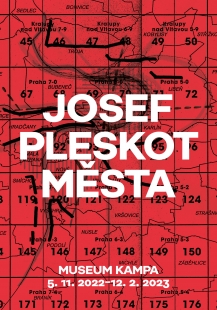
Josef Pleskot: Města - výstava v Museum Kampa
Pořadatel
Museum Kampa
Místo konání
U Sovových mlýnů 503/2, Malá Strana, Praha
Start
sat 05.11.2022 10:00
End
sun 12.2.2023 18:00
Odkaz
www.museumkampa.cz ...
Museum Kampa
Místo konání
U Sovových mlýnů 503/2, Malá Strana, Praha
Start
sat 05.11.2022 10:00
End
sun 12.2.2023 18:00
Odkaz
www.museumkampa.cz ...
Exhibitions
Czech Republic
Prague
Malá Strana
Josef Pleskot
AP ATELIER
Publisher
Tisková zpráva
Tisková zpráva
The exhibition Josef Pleskot: Cities, which Museum Kampa will host from November 5 to February 12 next year, will focus on three specific urban settlements where architect Josef Pleskot has the most realizations – Prague, Ostrava-Vítkovice, and Litomyšl. The showcase will not only present individual buildings and projects but has taken on the task of conveying Pleskot's approach to architecture, presenting the work of his studio in broader, more general contexts, and contributing to the answer to the question of the social role of architecture.
Josef Pleskot is the chief architect of the gradual transformation of Lower Vítkovice into a new cultural and social center of Ostrava. In addition to the already completed conversions of the oldest Vítkovice blast furnace into the lookout tower with the café Bolt Tower or the former gas holder into a multifunctional hall and conference center Gong, the exhibition will also feature the project of a new urban district, Městopark, for up to fifteen thousand residents, which is expected to – along with the residential complex Pod Žofinkou – connect the historical center of the city with the former industrial area.
While in Vítkovice, the architect's role is to seek new functions for abandoned factory buildings or even to define entirely new urban structures, in Litomyšl the focus is primarily on modifications and interventions aimed at further enhancing the architectural and urban qualities of a city with a long and uninterrupted cultural tradition and helping to fill it with new contemporary life. Among the most notable Pleskot realizations in Litomyšl are the reconstruction of the castle brewery, the regional museum, and the entire castle forecourt – now Václav Havel Square.
In Prague, Josef Pleskot is credited with the modification of Jelení příkop and the passage through the ramp of the Powder Bridge, the headquarters of ČSOB on Radlická Street and Metrostav at Palmovka, and the reconstruction of the Dominican monastery next to the Church of St. Giles in the Old Town. He is also the author of the upcoming residential project in Kavčí hory. The exhibition will, among other things, show that each of these projects is based on a comprehensive analysis of the specific site and existing landscape and urban relationships. Although these contexts may not be obvious at first glance, the final form of the building is determined much more by holistic criteria than purely formal ones. Josef Pleskot, who will celebrate his 70th birthday in early December, is among the most acclaimed architects of his generation and significantly transcends the boundaries of this profession with his social engagement. The exhibition, accompanied by a rich program, is curatorially prepared by architect Norbert Schmidt from Pleskot's AP atelier and chief curator of Museum Kampa, Jan Skřivánek.
Josef Pleskot is the chief architect of the gradual transformation of Lower Vítkovice into a new cultural and social center of Ostrava. In addition to the already completed conversions of the oldest Vítkovice blast furnace into the lookout tower with the café Bolt Tower or the former gas holder into a multifunctional hall and conference center Gong, the exhibition will also feature the project of a new urban district, Městopark, for up to fifteen thousand residents, which is expected to – along with the residential complex Pod Žofinkou – connect the historical center of the city with the former industrial area.
While in Vítkovice, the architect's role is to seek new functions for abandoned factory buildings or even to define entirely new urban structures, in Litomyšl the focus is primarily on modifications and interventions aimed at further enhancing the architectural and urban qualities of a city with a long and uninterrupted cultural tradition and helping to fill it with new contemporary life. Among the most notable Pleskot realizations in Litomyšl are the reconstruction of the castle brewery, the regional museum, and the entire castle forecourt – now Václav Havel Square.
In Prague, Josef Pleskot is credited with the modification of Jelení příkop and the passage through the ramp of the Powder Bridge, the headquarters of ČSOB on Radlická Street and Metrostav at Palmovka, and the reconstruction of the Dominican monastery next to the Church of St. Giles in the Old Town. He is also the author of the upcoming residential project in Kavčí hory. The exhibition will, among other things, show that each of these projects is based on a comprehensive analysis of the specific site and existing landscape and urban relationships. Although these contexts may not be obvious at first glance, the final form of the building is determined much more by holistic criteria than purely formal ones. Josef Pleskot, who will celebrate his 70th birthday in early December, is among the most acclaimed architects of his generation and significantly transcends the boundaries of this profession with his social engagement. The exhibition, accompanied by a rich program, is curatorially prepared by architect Norbert Schmidt from Pleskot's AP atelier and chief curator of Museum Kampa, Jan Skřivánek.
The English translation is powered by AI tool. Switch to Czech to view the original text source.

0 comments
add comment












